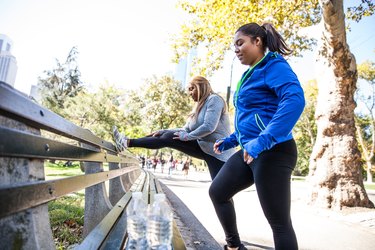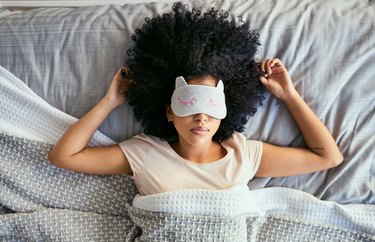
Whether due to genetic factors or lifestyle choices, some people simply tend to carry a little more fat around the pubic area, commonly known as the "FUPA" (fat upper pubic area).
While a miraculous fat-busting exercise would save time, it's unfortunately not possible to spot-reduce body fat. But improving your diet and exercise habits can help you lose total body fat, ultimately trimming any extra weight around the pubic area.
Video of the Day
Video of the Day
1. Know the Basics on Pubic-Area Fat
Everyone stores fat in adipose cells throughout the body, but some people have extra cells in certain areas, causing weight to gather there, according to Harvard Health Publishing. Those assigned female at birth (AFAB) tend to experience an increase in body fat as they age, especially around the hips and thighs, however weight loss is not contingent on sex; it depends more on genetics, physical activity and underlying health.
Typically, postmenopausal people begin to see more fat gather around the belly area, which can include the pubic area, according to the Mayo Clinic. This is due at least in part to decreasing levels of estrogen, which seems to affect where body fat is distributed in the body.
Ready to Lose Weight?
Set yourself up for success with LIVESTRONG.com's Weight-Loss Kickstart program.
Another factor that affects body fat levels is a decrease in muscle mass, which happens naturally with age, according to Harvard Health Publishing. Lean muscle mass keeps the metabolism high, helping the body burn fat. However, after the age of 30, people begin to lose 3 to 5 percent of muscle mass for each decade. Most people lose about 30 percent of their muscle mass in their lifetime.
Luckily, these factors can all be mitigated with a healthier diet, including a safe cut of calories and some adjustments to your macronutrient consumption. Coupled with a consistent exercise regimen and a good sleep schedule, you can trim body fat, including fat that tends to stick around the pubic area or lower abdomen.
2. Eat a Quality Diet

Controlling your calorie intake is a key factor in fat loss. In order to lose weight anywhere in the body, you need to create a calorie deficit, according to the Mayo Clinic.
With the help of a food diary or calorie-tracking app, you can determine how many calories you need to maintain your current weight and then gradually create a safe 500- to 1,000-calorie deficit per day, which should result in roughly a pound of weight loss per week.
For example, if you need 2,500 daily calories to maintain your current weight, you should aim to eat between 1,500 and 2,000 calories per day. Just make sure you don't dip below 1,200 to 1,500 calories per day.
Along with controlling your calorie intake, clean up your diet by choosing high-quality, unprocessed foods. According to a May 2019 study in Cell Metabolism, eating processed foods can cause overconsumption of calories, resulting in weight gain.
Choosing a diet rich in fiber will help you feel fuller for longer and can speed up your digestion, too, according to the Academy of Nutrition and Dietetics (AND). Choose meals rich in veggies and legumes to increase your daily intake.
Tip
The average adult should aim to get between 25 and 38 grams of fiber per day, according to the AND (and most people get less than half of that).
Protein low in saturated fat, such as grilled chicken, lean ground beef and fish, should also be included in your meals.
Protein is a powerful macronutrient in limiting your body's production of ghrelin, a hormone involved in making you hungry, per a 2015 study in the American Journal of Clinical Nutrition. Consuming about 25 to 30 grams of protein per meal led to improvements in appetite and weight loss, researchers found.
3. Exercise Regularly to Lose Pubic Fat
Targeted core exercises, such as planks and hanging leg raises, help build strength and muscle in the region between your pubic bone and below your belly button. These moves do little to burn the fat there, however.
Total-body strength training is your best tool to combat body fat. The more lean body mass (or muscle mass) your body has, the less fat mass you retain, according to the Mayo Clinic. Muscle requires more calories, or energy, for your body to sustain than does fat and therefore causes you to burn more overall.
Shoot for at least two strength sessions per week, recommends the U.S. Department of Health and Human Services. Select workouts that address all of the major muscle groups, including your back, chest, arms, shoulders, hips and legs.
4. Address Unhealthy Stress and Sleep Habits

Stress can lead to poor eating habits and weight gain, especially in the lower belly and upper pubic area. High levels of stress are often associated with a buildup of visceral fat (fat around the abdomen). Stressors like financial concerns or family issues can take a toll, causing people to seek comforting foods, which are usually high in fat, sugar and calories, according to Harvard Health Publishing.
Unfortunately, stress levels can also take a toll on your sleep, causing weight gain or fat retention. Over time, insufficient sleep can inhibit your fat loss and even lead to weight gain, according to the Mayo Clinic.
Lack of sleep also affects your choices, driving you to overeat or pick less healthy foods. Commit to a good night's sleep by limiting screen time before bed, powering down electronics and making time for seven to nine hours of quiet rest.
- Mayo Clinic: "Sleep: The foundation for healthy habits"
- Harvard Health: "Why stress causes people to overeat"
- HHS.gov: "Physical Activity Guidelines for Americans"
- Mayo Clinic: " Find out how metabolism affects weight, the truth behind slow metabolism and how to burn more calories. By Mayo Clinic Staff You've probably heard people blame their weight on a slow metabolism, but what does that mean? Is metabolism really the culprit? And if so, is it possible to rev up your metabolism to burn more calories? It's true that metabolism is linked to weight. But contrary to common belief, a slow metabolism is rarely the cause of excess weight gain. Although your metabolism influences your body's basic energy needs, how much you eat and drink along with how much physical activity you get are the things that ultimately determine your weight. Metabolism: Converting food into energy Metabolism is the process by which your body converts what you eat and drink into energy. During this complex biochemical process, calories in food and beverages are combined with oxygen to release the energy your body needs to function. Even when you're at rest, your body needs energy for all its "hidden" functions, such as breathing, circulating blood, adjusting hormone levels, and growing and repairing cells. The number of calories your body uses to carry out these basic functions is known as your basal metabolic rate — what you might call metabolism. Several factors determine your individual basal metabolism, including: Your body size and composition. People who are larger or have more muscle burn more calories, even at rest. Your sex. Men usually have less body fat and more muscle than do women of the same age and weight, which means men burn more calories. Your age. As you get older, the amount of muscle tends to decrease and fat accounts for more of your weight, slowing down calorie burning. Energy needs for your body's basic functions stay fairly consistent and aren't easily changed. In addition to your basal metabolic rate, two other factors determine how many calories your body burns each day: Food processing (thermogenesis). Digesting, absorbing, transporting and storing the food you consume also takes calories. About 10 percent of the calories from the carbohydrates and protein you eat are used during the digestion and absorption of the food and nutrients. Physical activity. Physical activity and exercise — such as playing tennis, walking to the store, chasing after the dog and any other movement — account for the rest of the calories your body burns up each day. Physical activity is by far the most variable of the factors that determine how many calories you burn each day. Scientists call the activity you do all day that isn't deliberate exercise nonexercise activity thermogenesis (NEAT). This activity includes walking from room to room, activities such as gardening and even fidgeting. NEAT accounts for about 100 to 800 calories used daily. Metabolism and weight It may be tempting to blame your metabolism for weight gain. But because metabolism is a natural process, your body has many mechanisms that regulate it to meet your individual needs. Only in rare cases do you get excessive weight gain from a medical problem that slows metabolism, such as Cushing's syndrome or having an underactive thyroid gland (hypothyroidism). Unfortunately, weight gain is a complicated process. It's likely a combination of genetic makeup, hormonal controls, diet composition and the impact of environment on your lifestyle, including sleep, physical activity and stress. All of these factors result in an imbalance in the energy equation. You gain weight when you eat more calories than you burn — or burn fewer calories than you eat. While it is true that some people seem to be able to lose weight more quickly and more easily than others, everyone loses weight when they burn up more calories than they eat. To lose weight, you need to create an energy deficit by eating fewer calories or increasing the number of calories you burn through physical activity or both. A closer look at physical activity and metabolism While you don't have much control over the speed of your basal metabolism, you can control how many calories you burn through your level of physical activity. The more active you are, the more calories you burn. In fact, some people who are said to have a fast metabolism are probably just more active — and maybe fidget more — than others. You can burn more calories with: Regular aerobic exercise. Aerobic exercise is the most efficient way to burn calories and includes activities such as walking, bicycling and swimming. As a general goal, include at least 30 minutes of physical activity in your daily routine. If you want to lose weight or meet specific fitness goals, you may need to increase the time you spend on physical activity even more. If you can't set aside time for a longer workout, try 10-minute chunks of activity throughout the day. Remember, the more active you are, the greater the benefits. Strength training. Experts recommend strength training exercises, such as weightlifting, at least twice a week. Strength training is important because it helps counteract muscle loss associated with aging. And since muscle tissue burns more calories than fat tissue does, muscle mass is a key factor in weight loss. Lifestyle activities. Any extra movement helps burn calories. Look for ways to walk and move around a few minutes more each day than the day before. Taking the stairs more often and parking farther away at the store are simple ways to burn more calories. Even activities such as gardening, washing your car and housework burn calories and contribute to weight loss. No magic bullet Don't look to dietary supplements for help in burning calories or weight loss. Products that claim to speed up your metabolism are often more hype than help, and some may cause undesirable or even dangerous side effects. Dietary supplement manufacturers aren't required by the Food and Drug Administration to prove that their products are safe or effective, so view these products with caution and skepticism. Always let your doctors know about any supplements you take. There's no easy way to lose weight. The foundation for weight loss continues to be based on physical activity and diet. Take in fewer calories than you burn, and you lose weight. The 2015 Dietary Guidelines for Americans recommends cutting calories by 500 to 700 calories a day to lose 1 to 1.5 pounds (0.5 to 0.7 kilograms) a week. If you can add some physical activity to your day, you'll accomplish your weight-loss goals even faster. Knowledge about all of the mechanisms that impact appetite, food selection, and how your body processes and burns food is increasing. Your doctor or registered dietician can help you explore interventions that can help you lose weight. ShareTweet Aug. 30, 2017 References See more In-depth Products and Services Mayo Clinic Healthy Living Program Book: The Mayo Clinic Diet See also Boost your weight-loss confidence Getting the support you need BMI calculator Body fat: What happens to lost fat? Breakfast Calorie calculator Carbohydrates Show More Advertisement Mayo Clinic does not endorse companies or products. Advertising revenue supports our not-for-profit mission. Advertising & Sponsorship PolicyOpportunitiesAd Choices Mayo Clinic Marketplace Check out these best-sellers and special offers on books and newsletters from Mayo Clinic. NEW — Guide to Raising a Healthy Child 4 simple steps to a joy-filled life Improve Your Hearing and Balance Stop osteoporosis in its tracks The Mayo Clinic Diet Online"
- The American Journal of Clinical Nutrition: "The role of protein in weight loss and maintenance"
- Academy of Nutrition and Dietetics: "Fiber"
- Cell Metabolism:"Ultra-Processed Diets Cause Excess Calorie Intake and Weight Gain: An Inpatient Randomized Controlled Trial of Ad Libitum Food Intake"
- Mayo Clinic:"Counting calories: Get back to weight-loss basics"
- Harvard Health: "Preserve your muscle mass"
- Mayo Clinic: "Belly fat in women: Taking — and keeping — it off"
- Harvard Health: "Taking aim at belly fat"